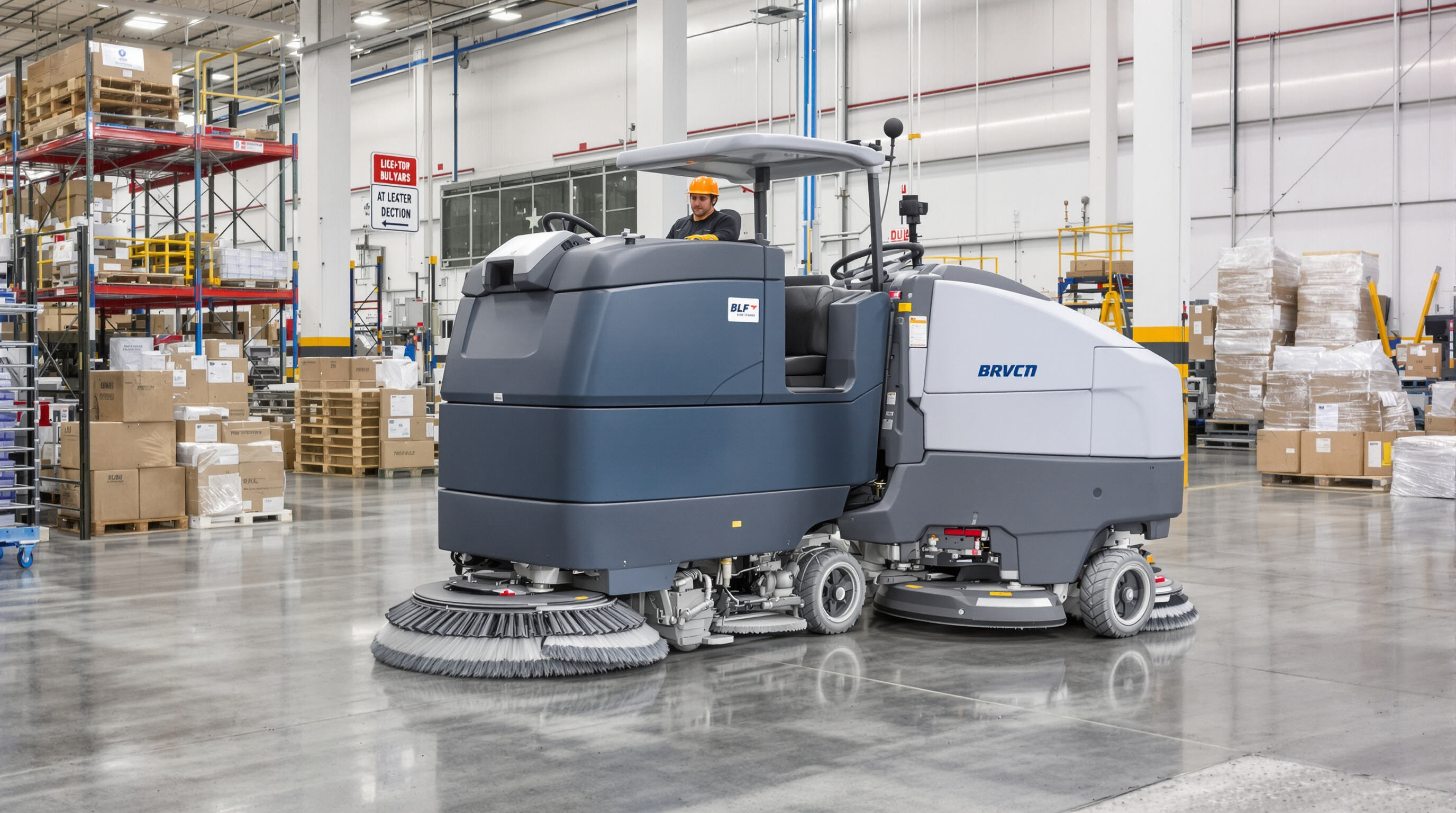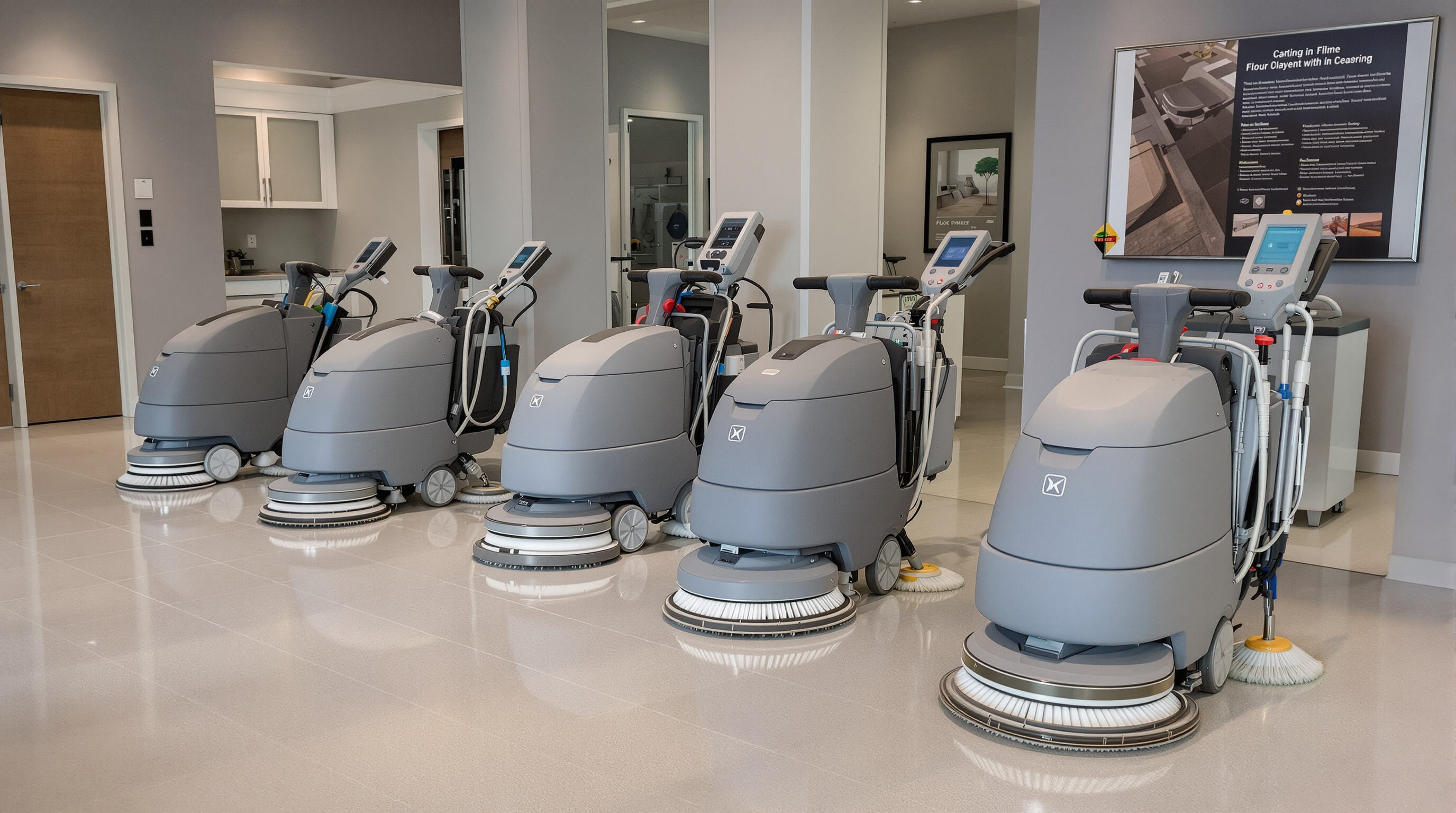Commercial Applications: Offices, Retail Stores, and Shopping Malls
How Floor Cleaning Machines Improve Efficiency in Office and Retail Environments
New generation floor cleaners cut down on hands-on work by about 40 percent for businesses according to Facility Management Journal from last year. Retail locations especially appreciate these machines since they keep foot traffic moving smoothly most of the time. Some research points to cleaning taking roughly two thirds less time than old school methods did back in the day. For office buildings, there are now quieter versions available that can run right through the workday without making anyone reach for earplugs or lose focus on their tasks at hand.
Automatic Scrubbers for Large Hard Floor Areas in Commercial Spaces
Walk-behind scrubbers clean 12,000–35,000 sq ft/hour in shopping malls, addressing polished concrete and sealed hardwood floors. Ride-on models with dual-brush systems remove 98% of surface contaminants in a single pass, critical for food courts and high-traffic corridors. These machines recycle 30% less water than conventional methods through advanced filtration.
Upright and Canister Vacuums for Carpeted Areas and Small Spaces
Cordless upright vacuums with HEPA filters capture 99.97% of particulates ≤0.3 microns, essential for corporate offices with air quality mandates. Canister models navigate retail fitting rooms and boutique spaces below 500 sq ft, combining 150-Aw suction power with <65 dB noise levels for daytime operation.
Case Study: Enhanced Cleanliness and Operational Efficiency in a Shopping Mall
A 1.2-million-sq-ft Midwest mall achieved 27% faster facility turnover after deploying 15 autonomous scrubbers. The implementation strategy reduced slip/fall incidents by 43% over 18 months while cutting nightly cleaning costs by $18,000/month through optimized water and chemical usage.
Industrial Applications: Factories, Warehouses, and Logistics Centers

Industrial floor cleaning machines address unique challenges in factories, warehouses, and logistics centers where heavy debris, oil residues, and constant foot traffic demand specialized solutions.
Handling heavy debris and high-soil environments with industrial floor cleaning machines
Industrial machines with tough brushes and powerful suction between 400 to 600 psi do a great job clearing away all sorts of debris from manufacturing floors including metal shavings, wood scraps, and concrete dust. According to research from the Ponemon Institute last year, factories that switched to these heavy duty cleaners saw a massive drop in slips and falls – around 72% fewer incidents when compared with old fashioned sweeping techniques. The real game changer though is those big recovery tanks holding anywhere from 20 to 30 gallons. They let operators keep running nonstop even during busy production periods without constantly stopping to dump out collected waste.
Sweepers and scrubbers for indoor and outdoor use in large logistics facilities
Compact ride-on scrubbers clean 40,000–60,000 sq ft/hour in warehouse aisles, while truck-mounted sweepers handle parking lots exceeding 100,000 sq ft. Recent analyses of logistics center operations show facilities combining scrubber-dryer units with sweepers reduce particulate matter by 89% in loading docks.
Pressure washers for exterior and heavy-duty cleaning in manufacturing plants
Cold-water pressure washers (2,500–4,000 psi) strip grease from factory floors 5x faster than manual scrubbing. Heat-resistant models operating at 180°F eliminate oil buildup on machinery foundations without damaging epoxy coatings.
Automated vs. manual cleaning: Impact on warehouse efficiency and labor costs
Automated floor cleaners operating on LiDAR navigation complete nightly cleaning cycles in 65% less time than manual crews, reducing labor costs by $18–$24/hour per worker based on 2024 industry reports.
Specialized Applications in Hygiene-Sensitive and Unique Environments
Steam Cleaners for Hospitals, Clinics, and Food Processing Units
Steam cleaners that reach high temps can knock out nearly all germs in places where cleanliness matters most, such as operating rooms and factory floors making food. The combination of steam at around 250 degrees Fahrenheit plus HEPA filters helps facilities stay compliant with food safety rules and infection control guidelines. Hospitals save hundreds of thousands each year on contamination problems when they switch from old methods. Research published last year in Nature points out how these steam units work better than regular mopping in areas needing strict ISO 4 cleanroom conditions. Traditional cleaning just doesn't stop microbes from growing back again after a while.
Carpet Extractors for Deep Cleaning and Stain Removal in High-Traffic Areas
Commercial carpet extractors remove 85% more embedded soil than standard vacuums through dual-motor systems and heated cleaning solutions. Ideal for hotels and convention centers, they address spills, biofilms, and particulate accumulation in dense nylon carpets while reducing water usage by 40% compared to older models.
Specialty Floor Cleaning Machines for Grout, Wet Surfaces, and Challenging Substrates
| Surface Type | Machine Class | Key Feature |
|---|---|---|
| Grout lines | Rotary brushes | 360° bristle penetration |
| Wet processing areas | Squeegee-vac systems | 2,500 Pa suction |
| Uneven terrain | All-surface scrubbers | Adjustable pressure (5–15 bar) |
These tools prevent slip hazards in breweries and maintain historical tile floors where conventional equipment causes surface degradation.
Adapting Floor Cleaning Machine Use to Unique Facility Requirements
Leading manufacturers now offer modular designs that swap brushes, tanks, and suction components to transition between sterilizing hospital corridors and degreasing industrial kitchens within minutes. This adaptability meets evolving sanitation standards while minimizing equipment redundancy.
Indoor vs. Outdoor Use: Matching Floor Cleaning Machines to Environment
Key differences in machine requirements for indoor and outdoor cleaning
When it comes to cleaning floors inside buildings, maneuverability and protecting surfaces are top concerns for most operators. According to recent maintenance reports from 2023, nearly four out of five facility managers rank noise levels as extremely important when choosing equipment for office areas. That makes sense since nobody wants their workplace sounding like a construction site during regular hours. For stores and shops, machines with non-marking rubber wheels and smaller footprints work best because they can weave through aisles without damaging flooring materials. Now looking at outdoor cleaning needs, these machines need bigger dirt collection bins - about 40 percent more space compared to what's used indoors. They also come equipped with special air pressure systems that keep dust from floating back up where people walk in and out of buildings. This helps maintain cleaner appearances while reducing health risks associated with airborne particles.
All-terrain sweepers and scrubbers for variable outdoor conditions
Industrial-grade sweepers combine articulating brush systems with 360° obstacle detection to maintain cleaning paths across uneven parking lots and loading docks. Municipal maintenance crews report 2.3x faster debris removal using self-adjusting scrubbers that automatically modify water flow and brush pressure when transitioning between concrete sidewalks and asphalt roadways.
Durability and weather resistance in outdoor floor cleaning machine design
Weatherproof models feature:
- IP65-rated sealed motors resisting heavy rain operation
- UV-stabilized polypropylene bodies preventing material degradation
- -20°C to 50°C operational range through heated battery compartments
Manufacturers achieve 12,000+ hour lifespans in coastal environments through triple-coating galvanization processes that combat saltwater corrosion.
Choosing the Right Floor Cleaning Machine by Floor Type, Soil Level, and Facility Size

Matching Machine Type to Floor Surface: Tile, Concrete, Carpet, and Epoxy Coatings
Choosing the right floor cleaning equipment starts by looking at what kind of surfaces need attention. Concrete floors found in warehouses typically need industrial strength scrubbers equipped with those special diamond pattern brushes that get rid of stubborn dirt and grime. According to recent industry data from 2024, these specialized brushes cut down on surface damage by about 42 percent when compared to regular brushes. When dealing with shiny tiles or epoxy coated floors often seen in lab environments, it makes sense to go for slower speed automatic scrubbers. These help avoid chemical damage to the surface while still keeping things safe from slips. Office carpets present their own challenges too. Most commercial spaces work best with upright vacuum cleaners featuring around 150 AWG suction power plus HEPA filters that trap nearly all small particles down to 0.3 microns in size. The latest machines coming out have smart sensors built in now, which can detect different floor types and adjust brushing speed and water output accordingly. Some studies suggest this tech boost cleaning results by roughly 31 percent across buildings with multiple floor types according to Warehouse Operations Journal last year.
Selecting Equipment Based on Soil Type: Dust, Grease, Grime, or Chemical Residue
Soil composition dictates technology choices:
- Grease-heavy kitchens: Steam cleaners operating at 320°F dissolve fats 4x faster than chemical alternatives
- Fine dust environments: Cyclonic vacuums with 3-stage separation handle 53 lbs/hr of particulate matter
- Chemical spills: Scrubbers featuring pH-neutralizing tanks and corrosion-resistant squeegees
A 2023 Facility Management Study found facilities matching equipment to soil types reduced chemical use by 58% and labor hours by 50%. For oil refinery floors, regenerative air sweepers achieve 98% debris recovery versus 82% for standard models.
Scaling Solutions From Small Shops to Mega-Warehouses
Equipment requirements vary dramatically by space:
| Facility Size | Recommended Equipment | Coverage Capacity |
|---|---|---|
| <5,000 sq ft | 18" walk-behind scrubbers | 1,200 sq ft/hour |
| 5,000–100,000 sq ft | Rider scrubbers with 40" decks | 15,000 sq ft/hour |
| >100,000 sq ft | Autonomous scrubber fleets with IoT routing | 24/7 operation capabilities |
Large logistics centers using scaled systems report 60% lower water consumption and 45% faster turnaround times between shifts (2024 Material Handling Benchmark). Battery advancements now enable 8-hour continuous operation in lithium-powered models, critical for mega-warehouses.
FAQ Section
What are the advantages of using floor cleaning machines in commercial spaces?
Floor cleaning machines enhance efficiency by reducing cleaning time and labor costs, while improving cleanliness and safety. They minimize water usage and reduce slip/fall incidents, contributing to overall operational improvements in commercial environments.
How do industrial floor cleaning machines address debris and high soil levels?
Industrial floor cleaning machines utilize powerful brushes and suction mechanisms to effectively remove metal shavings, wood scraps, and debris in factories and warehouses. They also feature large recovery tanks for uninterrupted operation during busy production periods.
Can floor cleaning machines be used in hygiene-sensitive environments?
Yes, specialized machines like steam cleaners and HEPA-filtered vacuums are used in hygiene-sensitive areas like hospitals and food processing units, helping to maintain strict sanitation standards and compliance with infection control guidelines.
What factors should be considered when choosing cleaning machines for different floor types?
Consider the floor surface, soil type, and facility size. Machines should be matched to the type of surface and contamination present, with features to handle specific soil compositions like grease, dust, grime, or chemical residues. Facility size impacts equipment requirements for effective coverage.
Table of Contents
- Commercial Applications: Offices, Retail Stores, and Shopping Malls
-
Industrial Applications: Factories, Warehouses, and Logistics Centers
- Handling heavy debris and high-soil environments with industrial floor cleaning machines
- Sweepers and scrubbers for indoor and outdoor use in large logistics facilities
- Pressure washers for exterior and heavy-duty cleaning in manufacturing plants
- Automated vs. manual cleaning: Impact on warehouse efficiency and labor costs
- Specialized Applications in Hygiene-Sensitive and Unique Environments
- Indoor vs. Outdoor Use: Matching Floor Cleaning Machines to Environment
- Choosing the Right Floor Cleaning Machine by Floor Type, Soil Level, and Facility Size
-
FAQ Section
- What are the advantages of using floor cleaning machines in commercial spaces?
- How do industrial floor cleaning machines address debris and high soil levels?
- Can floor cleaning machines be used in hygiene-sensitive environments?
- What factors should be considered when choosing cleaning machines for different floor types?


